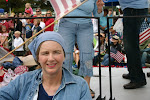Classic Concert Review: Billy Idol
Billy Idol at the Long Beach Arena, March 21, 1984
Not many people can rock for two hours straight but Billy Idol can. He provided his own brand of polished punk (a contradiction, but a good one) at the Long Beach Arena on March 21 as part of his spring tour. Unlike the vast majority of British punk rockers recently, Idol has focused on polishing and improving the basics of punk instead of simply tacking on outside influences. He doesn't need a "who cares if it's in tune" attitude to get New Rock cred, and his music doesn't have a distorted bass line, either. He's got things in tune and in balance, at least by New Wave standards. Although some of the polish was swallowed by arena-show accoustics and signs of road fatigue, there was still enough punky pulse to make the evening worthwhile.
Idol is a musical artist whose looks are so often commented on that people forget he can sing. He's got a big belting classic rock 'n' roll voice, exactly like what Janis Joplin used to have (even if he's male and she was female). He has a tenor but belts a blues line--just like she had a soprano but could belt a blues line. He belongs in the same circle of vocal greatness she did, because like her, he's capable of injecting great tenderness and savagery into the same song, even the same note.
Although Idol as an entertainer can carry the two hours this show lasted, unfortuantely there were signs his voice was at the limits of the demand placed on it. The first several songs played as warm-up's, with the music often overpowering the vocals. Then came "White Wedding," when Idol hit his stride, and the rest of the show--particularly the highlights "Rebel Yell," "Love Calling," and "Do Not Stand in the Shadows," were an incredibly satisfactory experience even had the entire show stopped right there. Road fatigue showed again on "Dancin' With Myself," but Idol still found strength for two encores, his hits "Hot in the City" and "Boney Maroney." He'd be advised to place those songs in the earlier, slower portion of the set and make something else the encore.
Idol's current band includes guitarist Steve Stevens, as intergal to Idol's sound and shows as Keith Richard is to the Rolling Stones. Steve Webber is the bass guitarist, Thommy Brice the drummer, but the female keyboardist, who also does backing vocals, goes inexcusably uncredited. All worked as an ensemble behind the star, adding to the show without showing off and calling undue attention to themselves.
Even with road fatigue showing, the music was incredible. The visual part of the show--the lighting--wasn't. The green, purple, red, and blue spots were distracting and reduced Idol to a blob onstage--exactly the opposite effect of what stage lighting's supposed to accomplish. Plus, what's this cliche of killing all lights at the end of every song? Are we the audience too dumb to know the song's over unless the lights go out?
Although there's room for minor criticism of this show, however, the overall effect was simply incredible. Few artists of Idol's status--still trying to establish himself as a top star, basically--even attempt a two-hour arena show. Idol has everything going for him--voice, looks, charisma, audience, musical material, and backing band. After nearly ten years in the business, Idol's breaking--and that's encouraging to the rest of the New Music scene.


0 Comments:
Post a Comment
Subscribe to Post Comments [Atom]
<< Home